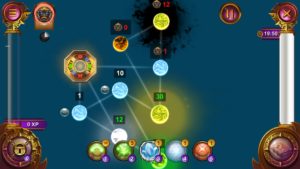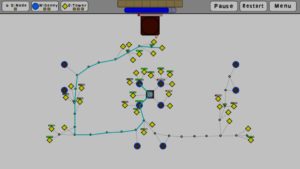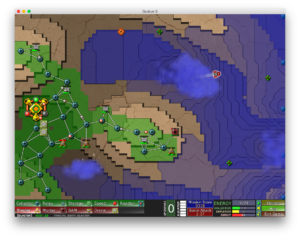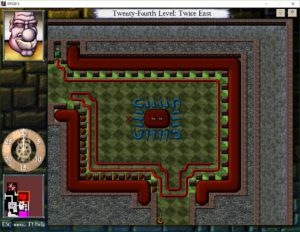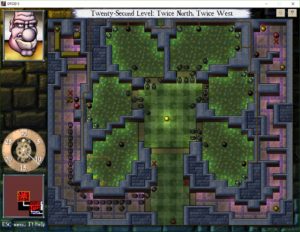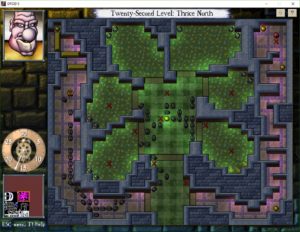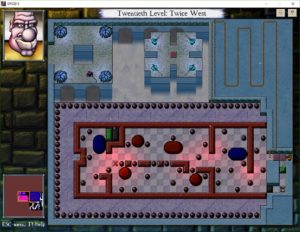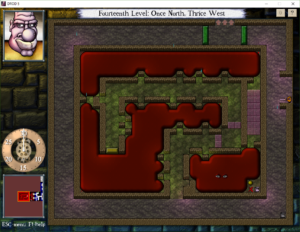Open Sorcery
I’ve been meaning to check out Open Sorcery since meeting its author at Indiecade last year, and I finally got around to purchasing it in the recent Steam sale. Since then, it’s become a finalist for Best Game in the Xyzzy Awards. And having played through it now, I see why. It’s a very engaging work, and one that goes to great lengths to meet the player halfway.
The basics: This is a story of AI awakening in a world of modern magitech. You play the role of BEL/S, a firewall that’s also a fire elemental, conjured and programmed by two friends and charged with keeping them and their kith and kin safe from evil spirits. Unusually for a commercial release, it’s written in Twine 1I know of only two other Twine games on Steam: Depression Quest and This Book is a Dungeon. And only one of those costs money. Firewatch gets an honorable mention here for having an intro that was prototyped in Twine and then put into the game more or less as-is. — there are a few pictures, but for the most part, output takes the form of text, and input takes the form of clicking on text. (There’s at least one moment of of freeform text entry as you guess at a chaos spirit’s riddles, but even this is done by clicking letters on the screen.)
Now, the point of view is decidedly nonhuman, unfamiliar with human things, and prone to describing stuff in a mixture of technical jargon and poetry. That has the potential to create confusion and communication problems — particularly in a choice-based game. I’ve certainly seen Twine pieces involving AIs or aliens or whatever where I had no idea what was going on, even after playing all the way through. Parser-based IF usually manages to avoid this by making progress contingent on understanding. As such, its failure mode is the player not making it all the way through, but even this is often avoided, because most information takes the form of room and object descriptions, which the player can view again when confused.
All of which is to say that Open Sorcery does an incredible job of keeping the player oriented. To start with, it makes use of routine. The game plays out over a series of days, and your primary task on each day is the same: visit the same four locations, look for signs of evil spirits, scan for any you find, and deal with them. On most days, there’s exactly one location with a spirit to confront, but you have to visit the other locations too, the better to experience plot elements that haven’t reached a crisis yet. There’s freedom within this structure, of course — once you locate and identify an evil spirit, you get to decide what to do about it.
Now, every spirit has two attributes, Matter and Motive, that you have to choose from a list of possibilities to identify it. (For example, BEL/S’s Matter is Fire, and her Motive is Order.) This is a necessary part of initiating an encounter; if you don’t know what you’re looking for, it remains invisible to you, and your progress in the story is blocked until you get it right. How do you know which Matter and Motive to choose? By paying attention to its effects on the environment. Notice that this is more or less the condition that I just described as typical of parser-based IF, that progress is contingent on understanding. In form and in purpose, the identification step is a puzzle — just not a puzzle you’re likely to get stuck on.
There’s a Twine technique I’ve described before wherein clicking on a word or phrase replaces it with a different word or phrase, going through several possibilities before settling on a final one. As I described it before, this is used to represent the narrative voice trying out different descriptions, different ways of thinking about things. Here, it’s used largely for clarifications to bridge the gap between player and protagonist, human and nonhuman. In fact, it bridges that gap in both directions. There are links that clarify BELS’s native jargon, as when the words “physical password” are replaced with “key”, and there are also links that give BEL/S a chance to google things, learning that the “edible organic matter” is a peanut butter and honey sandwich.
One way that the game really goes out of its way to be clear about what’s going on: Whenever there’s a conditional based on your character stats, it lets you know. If there’s an option that’s unavailable because you don’t meet the requirements, it’s displayed but grayed out. If there’s a response that’s conditional, it gets an entire page to itself, with the stat identified. This game wants you to know exactly how it works. I find it intriguing how different my response to this was depending on the stat used. There’s basically two sorts of stat: there’s your firepower, used to determine success and failure in blasting spirits with fire, and there’s your relationship level with several characters, used to determine their reactions. I’m accustomed to games where the mechanical details of characters’ minds are hidden from the player, the better to maintain the illusion that they’re not machines. So seeing the game call attention to the relationship stats so vehemently felt a bit strange. Stats in combat situations, on the other hand, I take in stride — so much so that I didn’t even notice that it was being treated the same way until I started writing about it here.
I haven’t really gotten into the story yet, but this is already a longish post about a shortish game, so I’ll leave off for now. I’ll probably have more to say about it tomorrow.
| ↑1 | I know of only two other Twine games on Steam: Depression Quest and This Book is a Dungeon. And only one of those costs money. Firewatch gets an honorable mention here for having an intro that was prototyped in Twine and then put into the game more or less as-is. |
|---|
 Comments(0)
Comments(0)